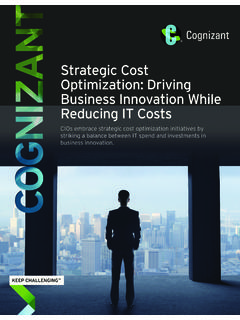Transcription of Digital workplace and culture How digital technologies are ...
1 Digital workplace and cultureHow Digital technologies are changing the workforce and how enterprises can adapt and evolveBy: Jennifer Buchanan, Specialist Leader; Beth Kelley, Manager; Alicia Hatch, CMO of Deloitte DigitalDigital workplace and culture 1 Many business leaders are currently operating under a traditional model : vertically integrated companies hiring full-time employees to work eight- to nine-hour shifts in a company s own office, campus or , the traditional way of doing business is quickly becoming outdated. Today s growth in technological capabilities, exponential increase in computing power available to both consumers and enterprises, and almost ubiquitous Internet connectivity among other Digital advances is changing the way employees and enterprises work. Organizations are benefiting from the increased digitization of the workplace through increased productivity, cost savings, a more mobile and agile workforce, and generally increased flexibility and adaptability in an ever increasingly complex marketplace.
2 Enterprises are collaborating more globally, and with more diverse and global staff. Employees can now work all over the world, from the jungle to the arctic, as long as they have reliable Internet. While this has been a boom for employers, it has also changed the power balance in the employer-employee relationship, often more towards the The ability to work from anywhere and stay connected through smart phones, tablets, and other mobile devices has enabled employees to stay connected and collaborate with peers and stay on top of Digital trends more readily than the organizations they work new Digital workplace also creates its own challenges, including security, developing a new kind of Digital etiquette to expectations for employees, and the tendency for building expectation of always being on, causing burnout and often leading to retention problems.
3 Integrating Digital technologies into the workplace can not only wreak havoc on the productivity of workers, but it also creates its own distinct culture , impacting the previous work culture and the general work experience. These changes will challenge the workplace by forcing both executives and employees to adapt the way they interact with each other and the technologies that enable their must be proactive in creating new systems and policies, and re-interpreting their corporate culture around Digital in the workplace , or they risk losing clients, productivity, and employees. Organizations that will succeed in this new Digital work environment are those that can be open to innovation and adopting new Digital methods, while also curating those Digital experiences for their employees, including creating distinct lines between work and non-work, and making the workplace overall more human-centered rather than technology-centered.
4 Technology the enabler The growth in computing speed and storage is making virtual and global collaboration possible in more fields every day. As technology and networks become more robust, the computing power available in consumer hardware continues to increase, and employees become more comfortable with working on their devices, rather than meeting face to face or having to come into an office. Having a more Digital savvy team has been a boon for employers. Technology supporting a digitally integrated workforce gets stronger and more robust every year, enabling enterprises to keep a very disperse team on the same page logistically and moving towards the same goals. Mobile computing is rapidly expanding access to the network of global workers connected by data as well as voice. Teams across time zones and countries can work remotely while staying connected to their teams virtually via Skype, VoIP, email, and cloud-stored files.
5 Companies no longer need to send workers on an expensive airplane ride to visit clients or collaborate with other teams. Technical and social mobility decouples people and organizations from physical geography and defined markets. Today s workforces are freer to go where they want to work instead of staying where work originates. Easier access to skill development resources is making vertical moves easier, too, for both people and organizations. 2 Companies are also able to create digitally integrated on-demand teams, offering the ability to tap into extensive networks of innovators, technical experts, and seasoned professionals from all over the world that can collaborate together. Researchers estimate that as many as 30 to 40 percent of all US workers today are These contingent employees and on demand teams create a level of agility for enterprises of all , new cognitive technologies are increasingly reengineering work.
6 This is a positive for both workers and enterprise as it replaces or augments work that was before very slow and tedious. Cognitive technologies are also creating new jobs, as these technologies both create and allow the analysis of datasets that were unheard of only a few years ago, creating new jobs for those with data science and analytics skills. On the other hand, some staff may be worried they will lose their jobs to a machine. The development of smart machines will continue to shift the workplace and force companies to not necessarily replace but redesign jobs to incorporate new technology solutions. Enterprises must work to integrate both smart machines and people into their talent networks. The face of the Digital workforceThis increase in communications and virtual connectedness has also opened the world to new ways of acquiring, developing, and managing talent and work, and is changing the way work is distributed and sourced.
7 In addition, it is also changing the perceptions that people have around work and working, and overall work a global talent pool, and one constantly in flux depending on needs, requires the ability to manage and mine large pools of employee and business data. A number of freelance and open source talent, product, and idea marketplaces have quickly evolved over the past several years. The analytics from these allow companies and employers to access, review, rank, analyze, and maintain millions of records on individual tasks, projects, and workers. At the same time, this also gives all employees a new power angle. Since current, contingent, and potential employees also have access to much of this data and technology, they are also learning to use it to their technologies have already dramatically impacted the culture around work and working.
8 This growing group of younger, connected, and mobile workers are managing their careers on their own terms and often outside of categories that have defined the workforce for decades. Today s workers have a new focus on purpose, mission, and work-life integration. They stay connected to friends and family digitally, and are comfortable working in the same way, often blending the two. More workers of all ages are demanding more of a work-life balance that can accommodate more time caring for family, living further away from city centers, or just avoiding peak commute times. For them, this balancing act includes utilizing Digital technologies to enable themselves and their broader are a particularly important demographic for organizations to pay attention to. They are the truly first Digital native generation, and the US Bureau of Labor Statistics predicts that by 2030 millennials will make up 75 percent of the As millennials grow into managerial roles, their priorities working for more than just a paycheck and leadership styles will have a huge impact on all organizations in the coming years.
9 Supporting a Digital culture provides a layer of flexibility and adaptability enterprises often lack. This struggle is especially pressing in more traditional industries that have been slower to adopt Digital and social strategies on a broader enterprise scale. Traditionally, HR, talent, and business executives think of talent and employee processes as a supply chain with an on ramp for new employees and an off ramp for retirees. However, today s employees are more nimble and willing to move laterally or to an entirely new company in order to achieve their career goals. Facilitating employees with Digital tools to make their work lives easier provides a necessary flexibility for both workers and shift to a more mobile and always available workplace has also adjusted the corporate mindset to a similar 24/7 approach, and impacted the way people think about work and the way they interact with and at work.
10 The way we communicate at work and with coworkers has changed dramatically. Digital has helped lead to a more casual attitude between co-working peers and bosses. For example, many people do not think twice when they see an emoji smiley face included in a professional email from someone they have never met in person. Digital workplace and culture 3 However, Digital has also created a divide from workers preferences to their workplace reality. In a world where a mobile phone is only an arm s reach away and the lines between work and life are increasingly ill-defined, work-life balance can be hard to achieve. Digital capabilities and technologies have potentially gotten ahead of workers and the traditional work culture . This kind of technology access can become addictive for some. It may feed well-meaning workers tendency towards working long hours and always being on, but in the end does not help overall productivity.











